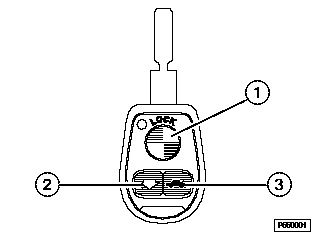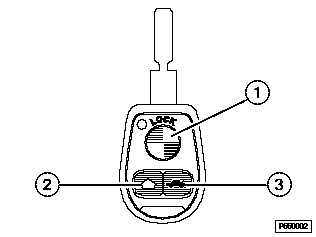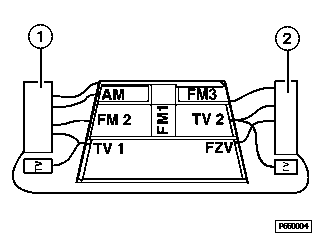
As of model year 1996, radio remote control is integrated in the general module of the ZKE III. The antenna used for this system is the radio antenna integrated in the rear window.
The radio signals are isolated in an antenna stop filter. The stop filter transmits the signals from the key transmitter via a data link to the general module.
All radio telegrams are coded and feature a constantly changing code so as to prevent manipulation and thus unauthorized opening of the vehicle.
Due to the different approval regulations for radio equipment in various countries, two different versions of the transmitter and stop filter are used.
For all European countries (EUR version)
Mainly intended for USA, Canada and Australia.
A differentiation must be made between two basic versions of key-chain transmitter:

Key transmitter ECE version, 433 MHz

Key transmitter US version, 315 MHz

Key-chain transmitter with rechargeable battery. In appearance, same version for 433 MHz and 315 MHz. The applicable frequency is printed on the back.
The three buttons on the key transmitter trigger, depending on how long they are pressed, various actions in the vehicle.
All radio remote instructions are encoded by means of a constantly changing code in order to prevent tampering in the system.
If transmission of radio remote instructions is disturbed during convenient opening/closing of the power windows, for safety reasons, the function is terminated immediately in the vehicle. The corresponding button on the key transmitter must be released and then pressed again in order to resume convenient mode functions.
The charge status of the battery or rechargeable battery in the key transmitter is monitored every time a button is pressed.
The key transmitter signals the battery status to the general module if the voltage reaches a lower limit value. The general module processes this message as follows:
If undervoltage occurs:
Note
In the case of key-chain transmitters with rechargeable battery as from 9/99 it should be noted that self-discharge, normal for rechargeable batteries, takes place while not in use. The rechargeable battery discharges after approx. 1 year. A fully discharged rechargeable battery must be recharged for approx. 30 hours until it has regained its full capacity.
The data sent by the key transmitter are received by the receiver module via a radio/TV antenna. An antenna stop filter (rejector circuit) isolates these radio waves from other received radio waves and transmits them via a line to the general module of the ZKE III.

Rear window antenna with AM/FM and stop filter
1 |
AM/FM amplifier for radio reception |
2 |
Stop filter (rejecter circuit) for radio remote control signal |

Rear window antenna with antenna diversity (special option on E39), TV antenna (special option) and stop filter
1 |
Diversity box for radio reception |
2 |
AM/FM amplifier for radio reception with integrated stop filter (rejecter circuit) for radio remote control signal. |
TV |
Antenna amplifier and stop filter for TV reception |
The radio signals are checked and evaluated in the general module. Valid instructions are carried out (e.g. release central locking system and disarm DWA).
The minimum range for instructions to the central locking system is 10 m.
The range is limited to a radium of approx. 5 m for the convenient opening and closing of the power windows and sunroof. The range is reduced for safety reasons.
During initialisation, the range is reduced to such an extent that this function must be carried out in the vehicle with the key transmitter pointing in the direction of the antenna.
A red LED indicates the function and battery status in the radio transmitter is integrated in the housing of key-chain transmitters from 9/96 to 9/99.
The self-test is used to check whether the transmitter electronic control is operating correctly.
The self-test is started by pressing and holding "tailgate" button and "lock" button simultaneously.
If the transmitter is functioning correctly, the red LED will light for 1 second.
The initialisation procedure allocates the key transmitter to the general module. During initialisation, a code is generated in the key transmitter and then transferred to the general module. The code is stored in the key transmitter and in the general module. The general module recognizes the keys belonging to the system on the basis of this code. Only commands from these keys are then carried out.
A maximum of 4 keys can be initialised for each vehicle. The codes of all other keys are deleted when a key is re-initialised. This means that all the keys of a system must be initialised simultaneously.
Carry out key transmitter initialisation in the vehicle interior.
Repeat the procedure as of Point 3 (= press and hold "unlock" button on key transmitter) to initialise the other keys. Terminal R must not be varied during this procedure.
The initialisation procedure is terminated if terminal R is switched on.
Note
In the case of key-chain transmitters up to 9/96 (with two batteries) the code stored in the transmitter will be lost if the key-chain transmitter has no voltage supply for a prolonged period of time. For this reason, the key batteries should be replaced within 1-2 minutes.